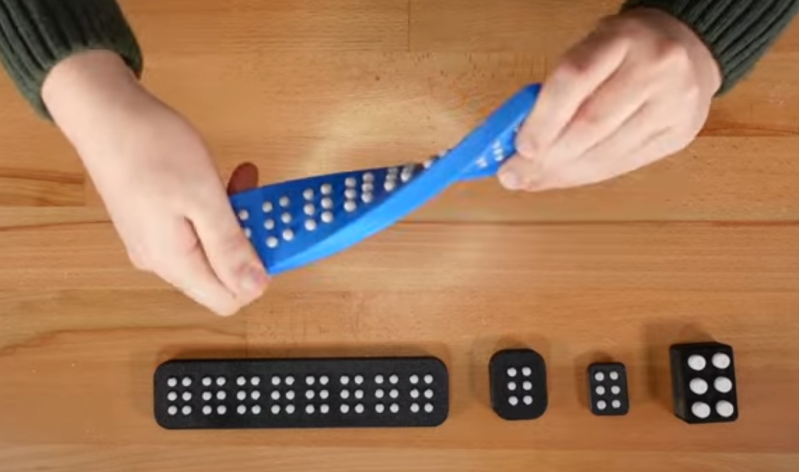Accessibility devices are a wonder of modern technology, allowing people with various needs to interact more easily with the world. From prosthetics to devices to augment or aid someone’s vision or hearing, devices like these can open up many more opportunities than would otherwise exist. A major problem with a wide array of these tools is that they can cost a fortune. [3D Printy] hoped to bring the cost down for Braille trainers which can often cost around $1000.
Braille trainers consist of a set of characters, each with six pins or buttons that can be depressed to form the various symbols used in the Braille system. [3D Printy]’s version originally included six buttons, each with a set of springs, that would be able to pop up and down. After some work and real-world use, though, he found that his device was too cumbersome to be effective and redesigned the entire mechanism around flexible TPU filament, allowing him to ditch the springs in favor of indentations and buttons that snap into place without a dedicated spring mechanism.
The new design is modular, allowing many units to be connected to form longer trainers than just a single character. He’s also released his design under the Creative Commons public domain license, allowing anyone to make and distribute these tools as they see fit. The design also achieves his goal of dramatically reducing the price of these tools to essentially just the cost of filament, provided you have access to a 3D printer of some sort. If you need to translate some Braille writing and don’t want to take the time to learn this system, take a look at this robotic Braille reader instead.
Thanks to [George] for the tip!















Fidget poppers could be improvised as a Braille trainer.
Didn’t realize they were so expensive. Helped someone with theirs, back in the day (everything sepia). Believed it used a serial connector.
Everything accessibility related is ungodly expensive. You get an unholy alliance of small run volumes for a niche customer base, having to build to a certain durability standard, and often insurance getting involved thus manufacturers can put the markup into the ‘how high is high? Higher than high! Money from here past the sky!’ level of pricing.
Source: I went to a school for the blind for a decade and I have special needs siblings.
Did some work for a big manufacturer of accusable bikes a while back. They had exactly 2 prices for their bikes, being “oof, could get a nice second hand car for that” and “wooof, could get a very nice new car for that”.
They had some standardisation in their models, meaning that a rear steer tandem or a wheelchair chariot could be made for a couple grand, but given that insurance had standardised pricing for these things, it wasn’t useful for them to charge less. So they didn’t. This meant they could subsidise the truly custom setups for people with atypical adaptations that often required significant engineering effort. It also financed a spectacular building and the most impressive modular and adaptive production line I ever saw.
You would think that it would be in the interests of insurance companies to do everything they can to make the stuff they pay out on have a lower cost.
If an insurance company is paying out, logic says it’s better for them to pay out less for the same thing since that increases their profit without increasing the cost to the consumer. (even if the consumer has to pay some of the money, it’s still better for both the insurer and the consumer if the overall cost is lower for the same product)
This is true.
An ex-gf of mine worked at Radio Shack back in the day and sold a lot of tape recorders / players to a small group of blind individuals. They could either buy a unit specifically adapted to their needs (sold by NIB) or they could by several regular players and use an L/R switch to switch between the audio tracks.
Since they were in RS we know they were buying the non-adapted units, and replacing them with very couple of years because they wore them out.
(Audio books for the blind are different than regular consumer audiobooks. They usually have the first audio track on one of the channels, when you get to the end you flip the tape and play the next segment. When that completes you flip the tape again, toggle the L/R switch, listen to the 3rd track, then flip the tape again to listen to the fourth track. This reduces the number of tapes required, as opposed to do it all in Stereo like a consumer audio book).
One thing I’d like to see is a way to connect/link individual cells into longer blocks or even matrices/pages.
Embedded magnets?